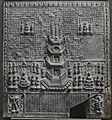Asuka period facts for kids
 |
|---|
|
The Asuka period (飛鳥時代, Asuka jidai), sometimes called Suikochō-jidai ("period of the Suiko court"), was a time in the history of Japan which lasted from around 538 through about 710. There is some overlap with the Kofun period which came before. There is also some overlap with the Nara period which comes after.
The Asuka period is named after the Asuka region, about 25 km south to the modern city of Nara.
Contents
Timeline
- 538: Introduction of Buddhism from China via Korean peninsula
- 593: Prince Shōtoku is regent for Empress Suiko
- 600: Yamato state sends the first Japanese diplomatic mission to China
- 607: Prince Shōtoku builds the Buddhist temple Hōryūji in Ikaruga.
- 645 (Taika 1): Emperor Kōtoku moves his capital from Asuka to Naniwa near the Bay of Osaka.
- 645 (Taika 1): Taika Reform and the establishment of provinces
- 672: Prince Ōama, later Emperor Temmu usurped the throne by winning the civil war (Jinshin no Ran) against Emperor Kōbun.
- 701 (Taihō 1): Code of Taihō was proclaimed.
- 708 (Keiun 5): A mint was established in the province of Ōmi. The mint made coins which are recognized as the first Japanese currency.
- 710 (Wadō 3, 3rd month): Empress Gemmei established her new capital in Nara, which was known then as Heijō-kyō.
Gallery
Related pages
- Metropolitan Museum of Art, Asuka and Nara Periods
- Japan-guide.com, Early Japan
Images for kids
-
A dragon-head pitcher with Pegasus pattern incised, gilded bronze with silver, Asuka period, 7th century, former Horyu-ji Temple treasures, Tokyo National Museum
-
Bronze plaque depicting Shaka delivering a sermon, dated 698 AD, Hase-dera Temple, Sakurai, Nara
See also
 In Spanish: Período Asuka para niños
In Spanish: Período Asuka para niños

All content from Kiddle encyclopedia articles (including the article images and facts) can be freely used under Attribution-ShareAlike license, unless stated otherwise. Cite this article:
Asuka period Facts for Kids. Kiddle Encyclopedia.






